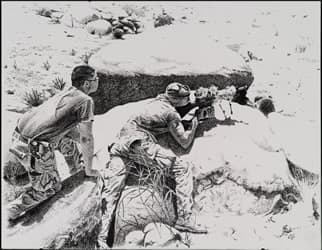
UNC Charlotte art student Rob Bates, who is earning a Bachelor of Fine Arts degree in illustration, has received Invitational Travel Orders to embed with the United States Marines as a freelance war artist on behalf of American Public Media's “The Story.” Bates will fly to Kabul, Afghanistan, on Wednesday, Dec. 5, and will be with a battalion of Marines from Camp Lejeune Dec. 8-18.
A former Marine who served eight years active duty, including two tours to Afghanistan, Bates began to create strategic combat art while in Afghanistan in 2004. He climbed hilltops to sketch the villages below and document the entrance and exit routes and other information necessary for military activity. Upon his second deployment in 2009, he bought a sketchbook and began to document people, places and events.
“At the time, I thought, this will be something cool for my son to have when I’m 60,” said Bates. But his work was discovered by Michael Fay, a highly regarded combat illustrator, who encouraged Bates to make his art public and has subsequently helped Bates to establish himself in the field of combat art. Work from that period was included in “The Joe Bonham Project,” organized by Fay and exhibited on the UNC Charlotte campus last summer. Bates’s sketchbook from his deployment is part of the National Museum of the Marine Corps Combat Art Collection.
 |
| "Paranoid Eyes" is a work by student Rob Bates. |
Bates calls this new project “Sketching the Draw Down.” He will produce radio segments for American Public Radio, which will be broadcast on WUNC radio and stations across the country.
“I want to come back with the truth about the war, from a non-biased perspective,” Bates said. “Are we ready to leave? Are they going to implode? I want to get the viewpoint of the soldiers.”
Bates says that his previous experience in the Marines gives him “a lot of leg to stand on.” He was in Afghanistan at the very early stages of the war and again during the middle. “From the military perspective, I know what to capture; I know what to expect.”
Bates believes that combat art is crucially important both to the history of art and the history of war. He cites artists like Winslow Homer, who was an artist for Harper’s magazine during the Civil War.
“Art can portray the war in a way no cold photograph can. We’re so numb to a lot of things, but when you see art, it’s a different approach.”